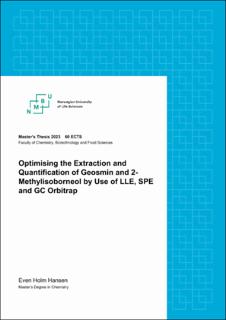| dc.description.abstract | Water is an incredibly valuable resource to humans. Concerns for distasteful contaminants in water sources emerged in the 70’s and has been observed to cause significant losses of water resources in recent years. Geosmin and 2-methylisoborneol are hydroxylated irregular sesquiterpenes and monoterpenes respectively and are widely recognised as two of the main compounds responsible for off-flavour and odour contamination in water. Humans possess incredibly low sensory thresholds for these compounds, ranging from a couple to around 50 ng/L. Because of these low sensory thresholds, these contaminants have gained worldwide attention, especially with regards to appropriate analytical methods to detect and quantify these contaminants. In this thesis, experiments were conducted in order to optimise aspects of extraction and quantification by liquid-liquid extraction (LLE) and solid-phase extraction (SPE), as well as GC Orbitrap. With respect to LLE, experiments involved an internal standard, solvent evaporation and microextractions. Factors including conditioning, optimisation of extraction, as well as quantification by use of internal standards and standard addition were investigated with regards to SPE. Temperature programming and split/splitless conditions were investigated with respect to GC Orbitrap. It was observed that these extraction methods in general did not perform well when compared to literature values, often including the use of other extraction techniques such as closed-loop stripping analysis and purge & trap, in addition to selected ion monitoring in mass spectrometry. Additionally, standard addition did not yield a reproducible method. However, novel improvements were made with the conditioning of SPE columns in order to extract and elute the analytes, increasing their quantification limits. A new internal standard candidate, 1-methylcyclohexanol, yet to be utilised in the literature, did exhibit promising response factors with geosmin in SPE analysis. Further research should include the application of more successful extraction methods from the literature with GC Orbitrap, as well as further investigations of 1-methylcyclohexanol as an internal standard candidate. | |
